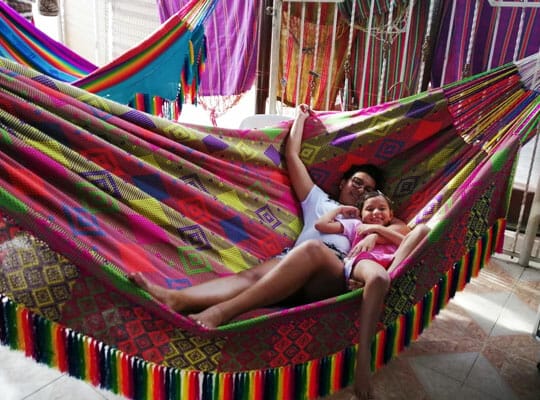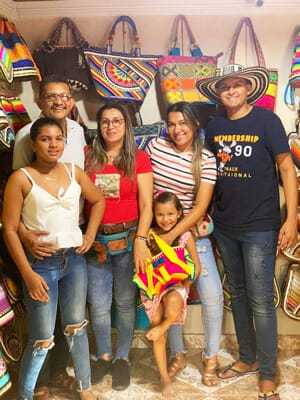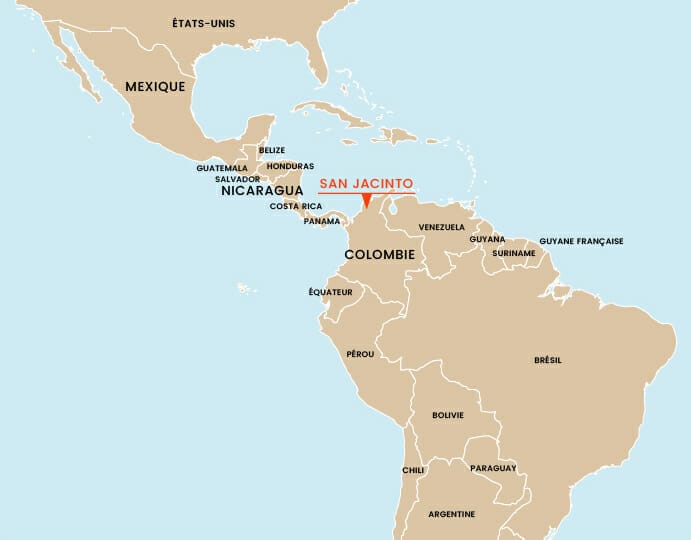
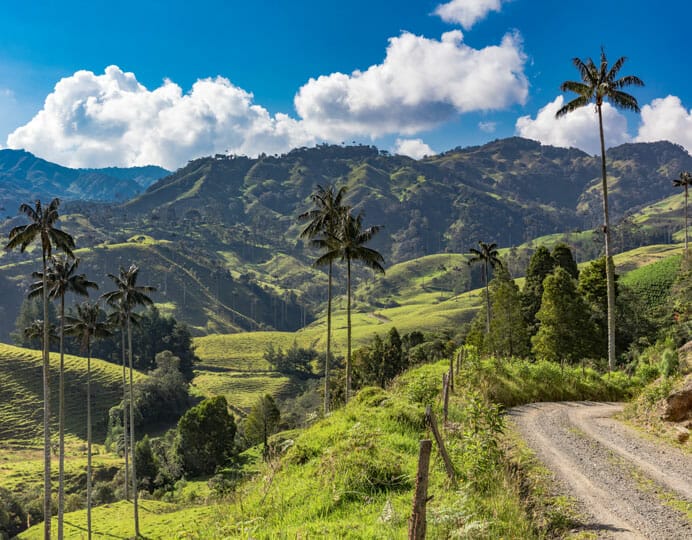
Colombia
Avant de parler du hamac de Colombie, intéressons nous à ce pays qui s’ouvre sur la mer des Caraïbes et sur l’Océan Pacifique et qui partage ses frontières avec le Panama, le Venezuela, le Brésil, l’Equateur et le Pérou. La faune et la flore de la Colombie sont aussi diversifiées que son climat et son relief. Sa flore est d’ailleurs reconnue pour être particulièrement riche, avec plus de 130.000 variétés de plante.
Il est difficile de retracer avec précision l’histoire précolombienne de la Colombie. En revanche, il est vraisemblable que les premiers habitants de la Colombie se soient installés sur le littoral bordant la Mer des Caraïbes aux alentours de 20.000 avant JC avant d’occuper rapidement l’intérieur du pays. D’abord nomades et chasseurs, les peuples ancestraux de la Colombie se sont sédentarisés en devenant des agriculteurs aux environs de 5.000 avant JC., notamment dans le massif montagneux de San Jacinto.
San Jacinto or the "Land of the Hamaca Grande
Descended from indigenous people and African slaves, the population of San Jacinto (28,000 inhabitants) is mostly peasant and artisanal.
It is known that the history of the hammock has its roots in pre-Columbian times when it was the pride of the indigenous people. In ancient times, this territory was inhabited by the aborigines of the Finzenu kingdom, one of the "three pre-Columbian kingdoms of the Zenu people", known for its textile production.
Tissés de la même manière que les indigènes le faisaient, les Hamacs de San Jacinto, sont reconnus dans toute l’Amérique du sud pour leurs spécifications traditionnelles, leurs tailles, leurs combinaisons de couleurs, leurs techniques de broderies et de marquages ainsi que la qualité de leurs tissus.
For over 5 centuries, it has been women, survivors of violence, poverty and lack of opportunity who have made hammocks to support their homes. It is they who have been responsible for preserving the trade. Since they were little girls, they have learned and received it as a family legacy. Between mothers, daughters, granddaughters, grandmothers, sisters and even neighbors, they meet in the workshops around the vertical looms built to carry out the different processes around the loom "such as winding, braiding or disassembling the loom.
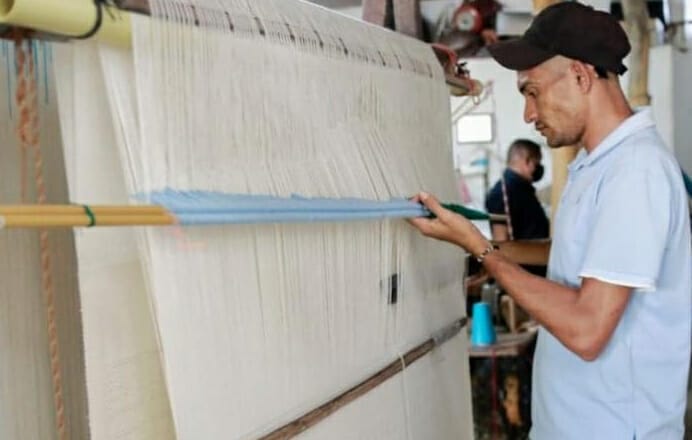
They make hammocks with brightly colored cotton threads or softened by natural dyes extracted from indigenous plants. They weave the hammock, thread by thread, on simple vertical looms with four poles, while their companions and children weave the heads on the troll (cotton ropes) to hang it. Finally, the hammock is woven in one piece, without finishing or sewing, which gives it a special value.
Nowadays, men and young people are increasingly involved in this craft tradition. The grandparents transmit the knowledge of the craft to the community and the younger ones devote themselves to the construction of the looms and to the marketing of the products that the weavers make with dedication.
Carlos, is a male artisan. Today, Carlos proudly belongs to that group of craftsmen who with their hands, make hammocks with a lot of love, leaving behind those myths that only women were fit to weave and that men had to devote themselves only to cutting wood to assemble and build the looms.
Manufacturing steps : Spinning, weaving, creating
Selection of the raw material
The cotton thread or "panaché" (cotton/acrylic) is the raw material with which the weavers give life to the hammock. In the past, the only way to obtain this yarn was by hand spinning the cotton produced in the territory. Today, to a greater extent, industrially processed yarns are used.
In the rarest cases, it is washed in a pan with soap and water so that the color of the material is fixed
To obtain the desired color, the skein is dyed in a container with hot water and pigments such as vinegar, bleach and salt, as well as anilines of different shades. These yarns are then washed and dried in an open terrace.
One of the indigenous techniques used on certain occasions, and which produces some of the most striking pieces, is that in which the dyeing process is carried out in parts through a system of knots that results in combinations with unique shades.
Selection of cotton yarns
 When the cotton is dry, the craftswoman carefully separates and untangles the fibers from the yarn, weaving them onto a winder, a four-armed wooden tool that can be used to sort the yarns with which the hammock will be made. Once the skeins are selected, the loom begins to be prepared.
When the cotton is dry, the craftswoman carefully separates and untangles the fibers from the yarn, weaving them onto a winder, a four-armed wooden tool that can be used to sort the yarns with which the hammock will be made. Once the skeins are selected, the loom begins to be prepared.
Installation of the loom
 The vertical loom is the tool where the hammock is woven. It is a structure that historically belongs to the Arawak or Arahuaca culture. In San Jacinto, the loom is made by men. It consists of a frame built with four wooden posts. It is used to make the threads beautiful and comfortable.
The vertical loom is the tool where the hammock is woven. It is a structure that historically belongs to the Arawak or Arahuaca culture. In San Jacinto, the loom is made by men. It consists of a frame built with four wooden posts. It is used to make the threads beautiful and comfortable.
Warping
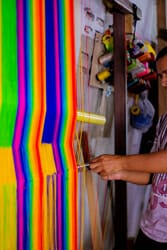 Once the loom is adjusted, the craftsman "throws" the threads into the "rovings" at each end to create the warp that leads to the beginning of the weaving. This process is known as "warping" and in this process it is important that the threads are stretched to their full width.
Once the loom is adjusted, the craftsman "throws" the threads into the "rovings" at each end to create the warp that leads to the beginning of the weaving. This process is known as "warping" and in this process it is important that the threads are stretched to their full width.
Intertwining
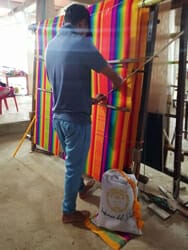 When all the threads are thrown on the loom, the craftsman assembles the "reed" with two corozo palm rods across the width of the loom. This separates the threads of the warp and weft of the fabric, as well as the weaving stick to achieve the interlacing of the threads.
When all the threads are thrown on the loom, the craftsman assembles the "reed" with two corozo palm rods across the width of the loom. This separates the threads of the warp and weft of the fabric, as well as the weaving stick to achieve the interlacing of the threads.
Weaving of the threads

 And so, pulling the reed with one hand and striking the hot warp with the "trowel", a wooden utensil with which the threads are fixed, the craftsman begins to weave with strength and expertise, weaving the thin threads horizontally into the fibers that are already on the loom.
And so, pulling the reed with one hand and striking the hot warp with the "trowel", a wooden utensil with which the threads are fixed, the craftsman begins to weave with strength and expertise, weaving the thin threads horizontally into the fibers that are already on the loom.
Making the "arms" of the hammock
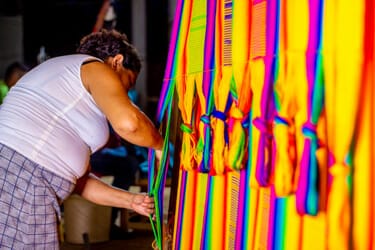
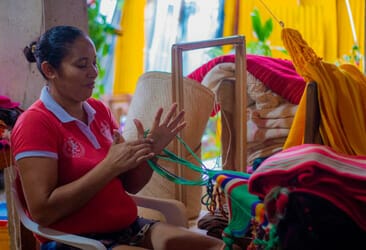 The "heads" or "gico" of the hammock are made with the non-woven threads at both ends of the piece. To do this, small braids are first made by hand that help the fabric not to unravel. Then, the threads of the heads are adjusted so that they are compact and strong when hanging the hammock.
The "heads" or "gico" of the hammock are made with the non-woven threads at both ends of the piece. To do this, small braids are first made by hand that help the fabric not to unravel. Then, the threads of the heads are adjusted so that they are compact and strong when hanging the hammock.
This is how Colombian craftsmanship materializes, a knowledge passed down from generation to generation that the people of San Jacinto carry in their hearts and hands and for which they have become known in the country and in the world.
A big thank you to the craftsmen with whom we collaborate, with a special mention to Mayi for her availability and her kindness!

